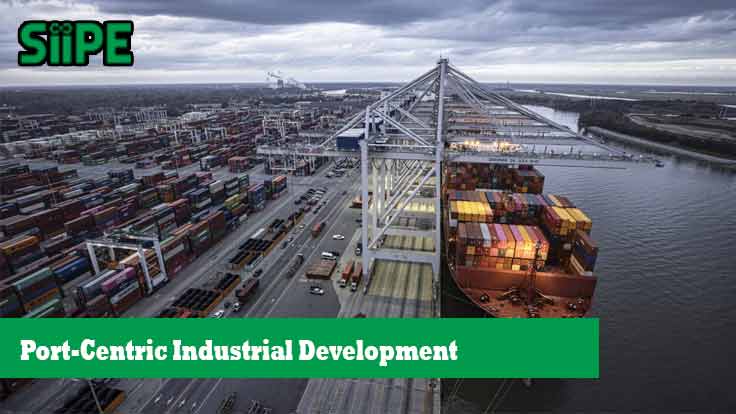As global trade continues to expand, the strategic role of ports becomes increasingly crucial. Ports are not only gateways for import and export activities, but they also serve as the heart of industrial and logistics ecosystems. This has led to the rise of port-centric industrial development—a model where industrial zones are planned and developed in close proximity to major seaports.
By aligning production, warehousing, and distribution facilities near shipping hubs, businesses benefit from lower logistics costs, reduced lead times, and improved supply chain efficiency. For developing economies, this model also offers a path to boost exports, attract foreign investment, and generate employment.
What Is Port-Centric Industrial Development?
Port-centric industrial development is the process of establishing industrial parks, warehouses, and logistics facilities directly adjacent to or within port areas. These developments are strategically designed to leverage the advantages of proximity to maritime infrastructure, such as container terminals, customs offices, and shipping lines.
Key elements include:
-
Integrated supply chain facilities
-
Multimodal transport access (road, rail, sea)
-
Customs and bonded logistics zones
-
Smart warehousing and automation systems
This concept has become a vital strategy in both emerging and developed markets, especially in response to growing e-commerce, just-in-time manufacturing, and global competition.
Benefits of Port-Centric Development
There are numerous advantages to adopting a port-centric industrial strategy, both for businesses and governments.
1. Reduced Transportation Costs
Locating manufacturing and warehousing close to the port significantly reduces last-mile delivery costs and time. Businesses can save on fuel, labor, and fleet management.
2. Faster Time-to-Market
In today’s fast-paced economy, speed is everything. Port-centric facilities enable faster customs clearance, direct loading/unloading, and quicker distribution to customers.
3. Improved Supply Chain Resilience
Having operations close to the port allows better control over cargo flows, buffer stock management, and real-time response to disruptions.
4. Lower Environmental Impact
Shorter transport distances mean lower carbon emissions. Many port-industrial zones now incorporate green logistics principles to support sustainable growth.
5. One-Stop Industrial Ecosystems
Port-centric zones often house multiple services—manufacturing, packaging, freight forwarding, and warehousing—streamlining operations and collaboration.
Global Examples of Port-Centric Industrial Hubs
Several countries have successfully implemented this model. Let’s look at a few notable examples:
1. Jebel Ali Free Zone (JAFZA), UAE
Adjacent to the Port of Jebel Ali in Dubai, this is one of the world’s most successful port-centric zones. It offers warehousing, manufacturing, and logistics support for over 7,000 companies.
2. Port of Rotterdam, Netherlands
Europe’s largest port features logistics parks and distribution centers linked by rail and road to the continent. It’s a model for multimodal integration.
3. Ningbo-Zhoushan Port, China
This hub includes bonded zones and manufacturing clusters. China’s port-industrial model accelerates exports and attracts global supply chains.
4. Port Klang Free Zone, Malaysia
Located near the largest port in Malaysia, it serves as a key hub for Southeast Asian manufacturing and logistics.
Indonesia’s Potential for Port-Centric Growth
Indonesia, with its vast maritime geography, holds enormous potential for port-centric industrial development. Some key regions showing promise include:
1. Belawan Port, Medan (North Sumatra)
Close to the Kawasan Industri Medan (KIM), Belawan supports palm oil, rubber, and fisheries exports. Developing more industrial space around Belawan could significantly boost North Sumatra’s trade ecosystem.
2. Tanjung Priok, Jakarta
Indonesia’s busiest port already houses bonded logistics centers. The integration of digital customs and smart logistics could turn it into a full-fledged port-industrial hub.
3. Patimban Port, West Java
With a focus on automotive exports, the adjacent industrial zones are expected to serve Japan-Indonesia joint ventures and high-tech manufacturing.
4. Bitung Port, Sulawesi
This eastern gateway is targeted for fisheries and agroindustry. Development of industrial facilities here would support economic equality across regions.
Key Sectors That Benefit from Port-Centric Development
Certain industries stand to gain more from proximity to port infrastructure:
-
FMCG and retail distribution
-
Automotive exports and components
-
Agro-industry and processed food
-
Textile and apparel manufacturing
-
Logistics and 3PL (third-party logistics) providers
For these sectors, minimizing transport time and customs handling is critical to competitiveness.
Smart Technologies Enhancing Port-Industrial Zones
The effectiveness of port-centric zones is further enhanced by the adoption of smart technologies, including:
✅ IoT and RFID Tracking
Real-time visibility into cargo movement helps reduce delays and theft.
✅ Warehouse Automation
Robotics and conveyor systems increase speed and accuracy in handling goods.
✅ AI-Powered Demand Forecasting
Helps manufacturers optimize inventory levels and reduce waste.
✅ Customs Digitalization
Online documentation and e-clearance reduce bureaucratic delays and corruption.
These technologies are transforming port zones into intelligent trade nodes in the global supply chain.
Challenges and Considerations
Despite the clear benefits, port-centric development faces several challenges:
❌ Land Availability
Ports are often located in crowded urban areas. Acquiring land for industrial development can be difficult and expensive.
❌ Infrastructure Bottlenecks
Without coordinated planning, access roads and railways can become congestion points.
❌ Environmental Concerns
Ports can be polluting. Sustainable planning and strict regulations are needed to reduce the ecological impact.
❌ Policy Coordination
Successful zones require collaboration between port authorities, industrial estate developers, and government regulators.
Strategies for Successful Implementation
To maximize the benefits of port-centric industrial zones, policymakers and developers should:
-
Develop master plans that integrate logistics, industrial, and residential functions.
-
Invest in infrastructure, including multimodal connectivity and clean energy.
-
Offer fiscal incentives such as tax holidays, import duty exemptions, and export support.
-
Promote international partnerships with global logistics firms and investors.
-
Create single-window clearance systems to reduce red tape for investors and tenants.
Port-Centric Zones as Engines of Modern Industry
Port-centric industrial development represents a forward-thinking model that aligns with the demands of modern trade, e-commerce, and global supply chains. By bringing production closer to export hubs, nations can reduce costs, attract high-value industries, and create jobs.
For Indonesia and other archipelagic nations, embracing this model offers a practical and powerful path to industrial growth and global competitiveness.











